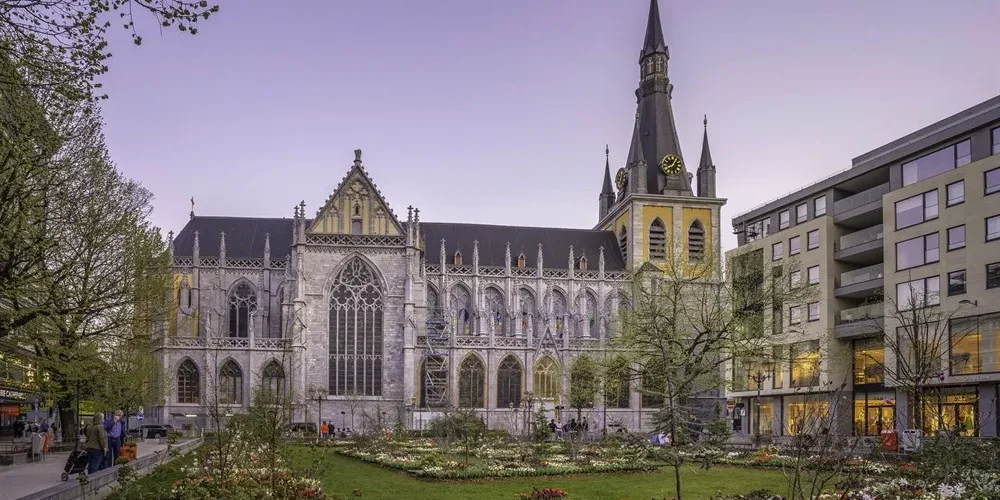Introduction
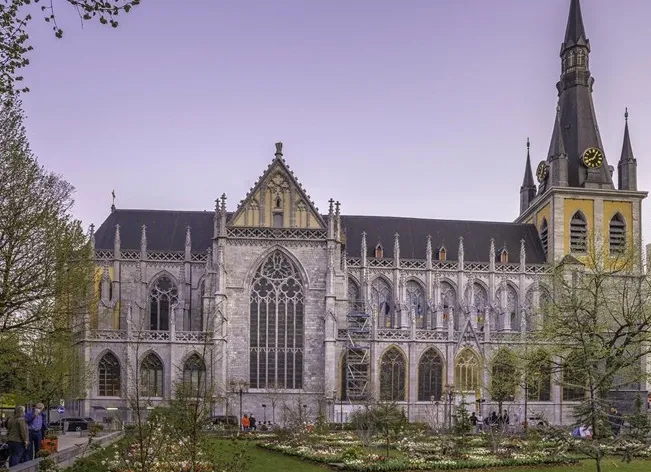
Liège Cathedral, otherwise St. Paul’s Cathedral (French: Cathédrale Saint-Paul), is a Roman Catholic cathedral in Liège, Belgium. Founded in the 10th century, it was rebuilt from the 13th to the 15th century and restored in the mid-19th century. It became a Catholic cathedral in the 19th century due to the destruction of Saint Lambert’s Cathedral in 1795. It is the seat of the Diocese of Liège.
St. Paul’s Cathedral
During the French Revolution the ancient cathedral of Liège, St. Lambert’s, was destroyed. After the revolution the former collegiate church of St. Paul’s was elevated in rank, becoming the current Liège Cathedral.
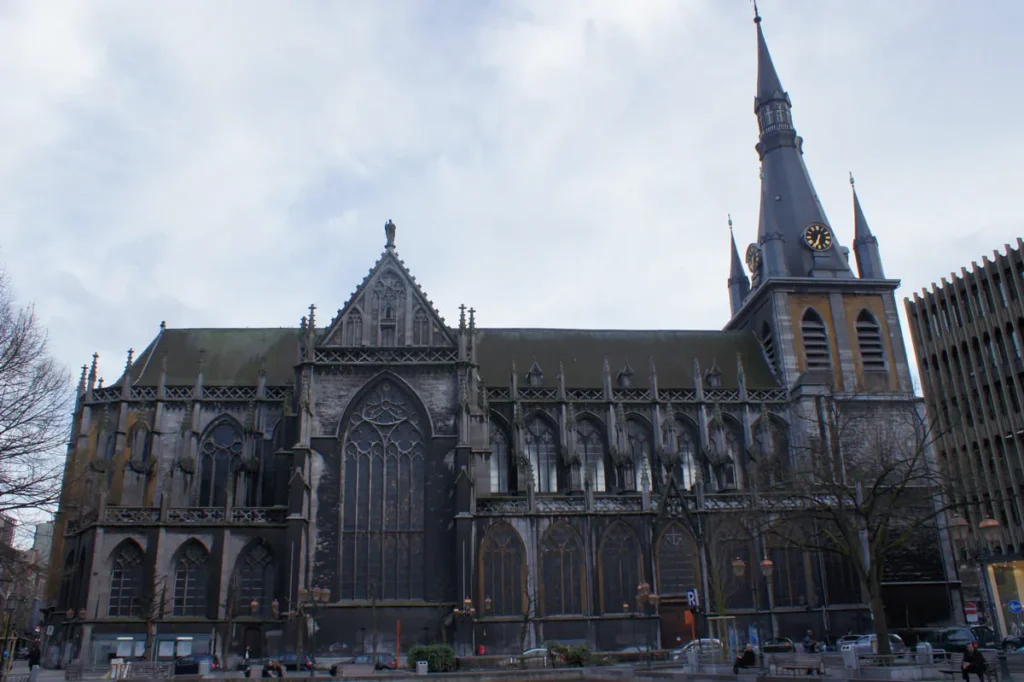
The Present Cathedral was formerly one among the Seven collegiate churches of Liège – St. Peter’s, Holy Cross, St. Paul’s, St. John’s, St. Denis’s, St. Martin’s and St. Bartholomew’s – which until the Liège Revolution of 1789 together comprised the “secondary clergy” of the First Estate in the Prince-bishopric of Liège (the “primary clergy” being the canons of St. Lambert’s cathedral).
Saint-Germain Chapel
In 967, Bishop Eraclus built this church. The basilica was raised only up to the windows when Eraclus died. He instituted a college of twenty canons to whom Notger, who completed the building begun by his predecessor, added ten more.
Saint Paul Collegiate
It was upon his return from Cologne, where he had attended the funeral of Bruno the Great, archbishop of that city and vicar of the empire, that Eraclus conceived the project of building a church in honor of Paul the Apostle.
First Allocations
Very little information remains concerning the goods which Eraclus endowed the college with twenty canons which he had created. It seems, however, that the bishop gave the tithes of the church of Lixhe (canton of Glons): what is certain is that the collation of this church, which was erected as a parish around 1200, belonged to the chapter of St. Paul until it was suppressed by the French on 27 November 1797. Notger solemnly consecrated this church on 7 May 972: two altars were dedicated to Germanus of Auxerre and St. Calixte, in memory of the worship previously rendered to these two saints in the chapels which had been dedicated to them. On 21 April 980, the fortress of Chèvremont was destroyed from top to bottom and the churches that were there demolished. One of them, dedicated to St. Caprasius, had a college of ten priests; the bishop gathered them together with the twenty canons of St. Paul and thus brought their number to thirty. All the property, pensions and tithes of St. Capraise were transferred to the new collegiate church, to which Notger gave the bell called “Dardar”, also from Chèvremont.
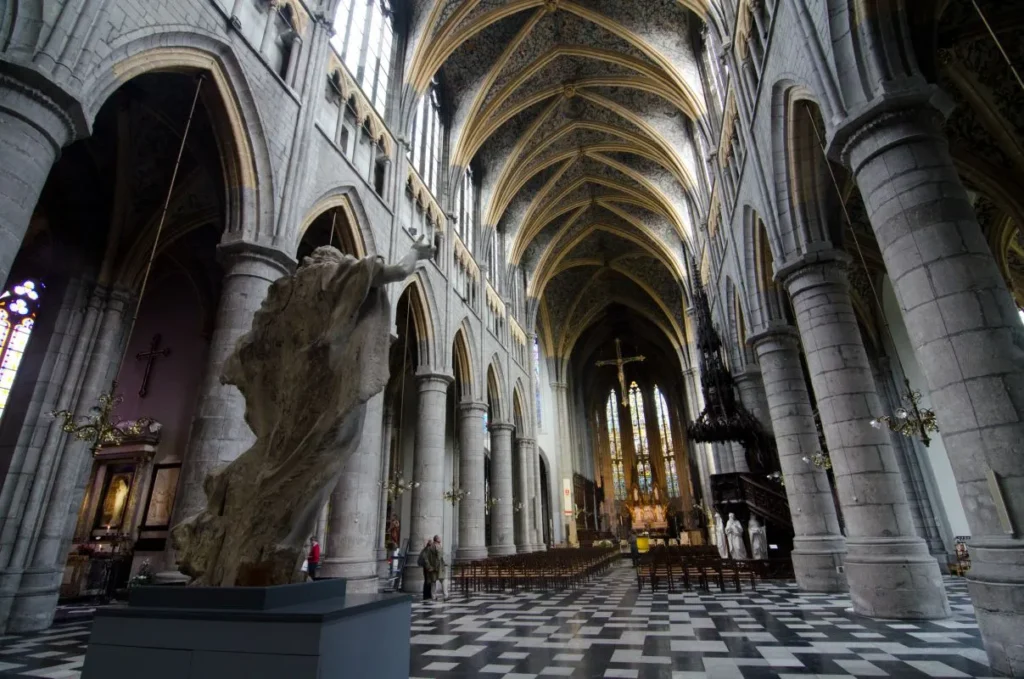
The apse, constructed in the 14th century in the Rayonnant style, is pentagonal. The choir, the transept, the main nave and the side naves date from the 13th century and have all the characteristics of Gothic architecture of that period. Later Gothic architecture occurs in the windows of the transept and of the nave, the side chapels and the tower. The upper gallery overloaded with pinnacle hooks is modern, as is the storey with the ogival windows and the spire of the belltower with four bells on each side. The lintel of the portal bears an inscription, formerly on the city seal: Sancta Legia Ecclesiae Romanae Filia (“Holy Liège, daughter of the Roman church”).
First known Provost and Deans
Godescalc
The first authentic mention of a dean and provost of St. Paul can be found in a piece from the year 1083, taken from the cartulary of this Collegiate Church. It talks about damages caused in the alleu of Nandrin, property of the chapter, by Giselbert, Count of Clermont, and his accomplice Frédelon. Bishop Henri de Verdun embraced the defence of the Church’s rights and in order to safeguard them in the future, the advocatus of Nandrin’s alleu was entrusted to a lord named Conon. This ceremony took place in the temple itself, on St. Paul’s Day.
A document from the following year attests to the existence of a cloister at that time and that the brothers of St. Paul were called canons. In 1086, Godescalc instituted several benefits (Eleemosynœ or Prebetidulœ). They were known for a long time as prebends of Wouteringhen or Wohange. This same year, he founded the altar of saints John the Baptist, Nicolas and Mary Magdalene. It’s the oldest simple profit establishment we’ve ever had. In 1101, Dean Godescalc was elevated to the dignity of Archdeacon of Liège, and died shortly afterwards.
Waselin
In 1106, the Collegiale added to its properties part of the territory of Fragnée, acquired and shared by Obert between the churches of the secondary clergy. To celebrate his birthday, on 24 March 1113, Wazelin donated to Saint-Paul his house with all its outbuildings. The latter rented the tithes of the church of Wendeshem for a rent of 5 Marcs of good money payable in Liège.
New Allocations
Godfrey I, Count of Louvain, in 1135, ceded the tithes of the city of Weert and its uncultivated or cultivated territory to the Collegiate chapter. In 1182, Dean Henry donated the parish church of Laminne to the chapter, which would keep it until it was abolished by the National Convention on 20 March 1797. He then bequeathed to the collegiate church the land of Hodimont. Ebalus became dean in 1185: in the same year, a letter mentions the transfer of the church of Hermalle-sous-Huy, to the Flône Abbey.[alpha 5] He gave to the collegiate the church of Lavoir, dedicated to Hubertus, whose St. Paul’s chapter kept the collation until 1797.
Pope Celestine III, by a diploma given in Rome on 14 April 1188, confirmed all its possessions to the church of Liège. Dean Jonah gave the collegiate to the church of St. George’s and the church of Verlaine dedicated to St. Remy in 1198.
Foundation of Val-Benoit and Val des Écoliers
Othon Des Prez, elected dean, founded the convent of Sart in 1220, on the left bank of the river Meuse, half a lieue away from the town, and five years later it was renamed the convent of Sart, which was renamed the convent of Val-Benoît, when Cardinal-Legat Conrad, Bishop of Porto consecrated the church on the day of Pentecost. He then had the priory of Notre-Dame du Val-des-Écoliers erected in Liège, in a place then called Gravière (now La Gravioule) and in Saint-Martin-en-Ile, he raised and endowed, with his own money, an altar in honour of Thomas Becket of Canterbury.
New Collegiate Church
The construction of the new building was probably hampered by a lack of funds and progress was slow. The tower seems to have been finished first; in 1275 the dean Guillaume de Fraynoir had two large bells given by him suspended: one, in honour of the patron saint of the church, was named Paula, and the other Concordia, the name of the mother of this apostle. Cast in July 1275, they announced the services celebrated by the dean. The second of these bells, Concordia, was still ringing in the 19th century; it rang the D of the organs and bore an inscription in Gothic letters.
Consecration
Everything leads us to believe that the reconstruction of the collegiate church was very advanced in 1289; indeed, on 11 April, both the consecration of the church and the blessing of the altars took place; solemnities celebrated by the two suffragans of Liège, Edmont, bishop of Courland in Livonia, and brother Bonaventure, of the Order of Citeaux, bishop of Céa.
Floods, Fires and Earthquakes
Floods
The coal mines surrounding Liège from the Early Middle Ages, despite the prohibition of digging under the town which was not always respected, digging downstream and upstream had the consequence of making Liège a basin and later a dyke. Despite the ramparts, floods followed one another from century to century.
On 4 January 1374, the river Meuse grew so big that the island’s neighbourhood was flooded as well as the collegiate church of St. Paul to the point where it could only be entered by boat. On 28 January 1408, a flood also damaged the books and jewellery in the crypt, part of the charters, the books, and the ornaments of the collegiate church kept in the treasury. To avoid similar disasters, the floor of the new bookshop was raised and one entered from there by a few steps.
Heavy flooding occurred in 1464. The snow had fallen in abundance for several days before the feast of St.Caprasius of Agen, the rains which followed brought such a flood that on the day after the feast of St. Élisabeth, the swollen floods of the Meuse threatened to invade the collegiate church. The canons only had time to block the door with a kind of dam and had to buy a boat to go to the matins. They used the same means to attend the hours until 23 November, when they were able to go to the services on dry foot.
On 7 February 1571 as a result of a flood, the water rose to a height of 6.40 meters. The memory of this overflow is preserved by the following chronogram engraved on the right pillar of the collegial background next to the jubé. The line indicating the height of the water is 0.84 cm from the current level of the paving stone.
On 15 January 1643, the flood that swept away the Pont des Arches covered the Latin Quarter of Liège and caused immense damage. The waters of the river Meuse rose in St. Paul’s church 1.35 meters above the current paving stone. The memory of this event is remembered by the following chronogram engraved on the pillar that supports the tower to the right of the jubé.
A metal plaque dating from 1926 is located to the right of the cathedral entrance indicating the height of the water at the time of the last flood. Since the installation of the mud and water drain from downstream and upstream sewers, no further flooding has occurred.
Completion of works and paintings by Lambert Lombar
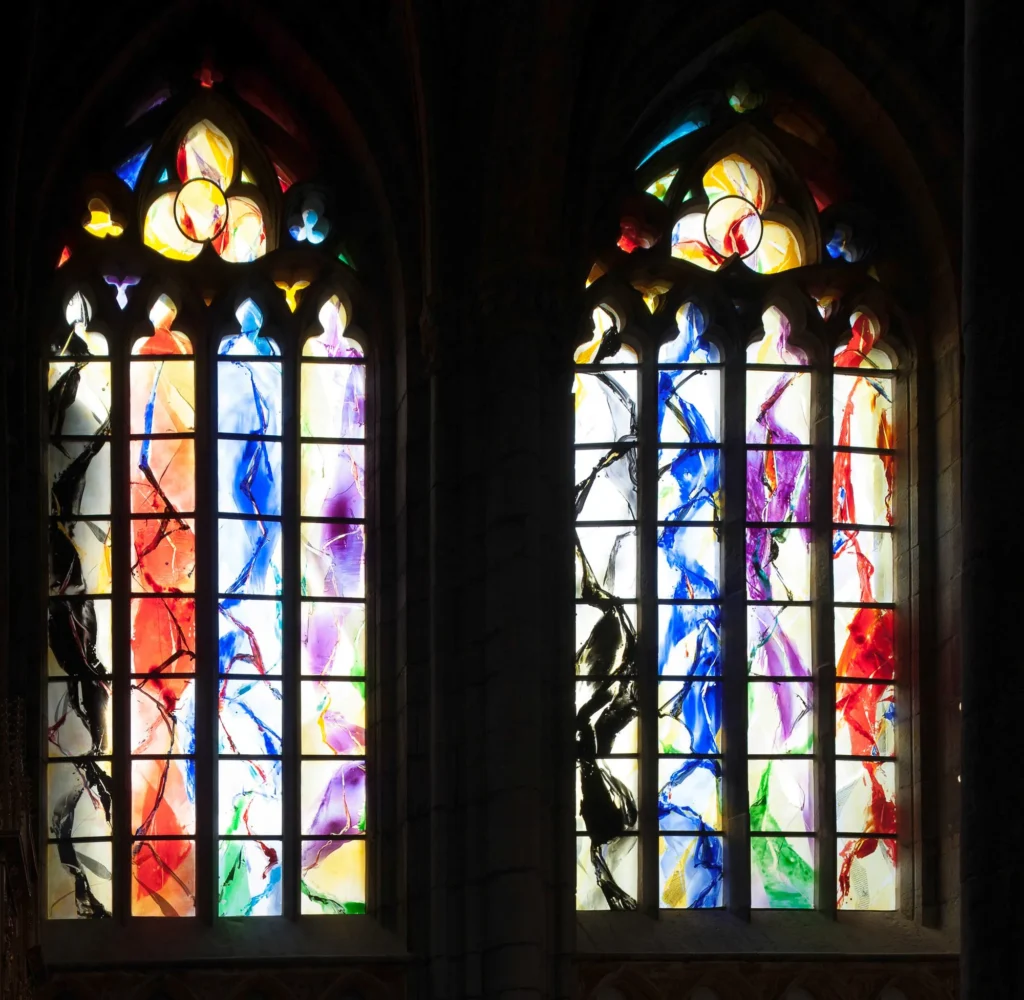
Lambert Lombar
In 1528 and 1529 several works were executed, among others paintings which according to a manuscript are the work of Lambert Lombard and his pupils.
Glass canopy
In 1530, by the munificence of Léon of Oultres, the collegiate church was enriched by the large canopy illuminating the left arm of the transept at midday. This window escaped the ravages of the French Revolution. On the contrary, the one facing it was completely destroyed.
Windows
In 1557 and 1558, major works were still carried out on the church. The first date can be found on the central window on the south side and on the vault in front of the large nave; it probably indicates the time of construction or repair of the windows on this side. The second is on the corresponding window on the north side.
Western portal
The construction of the west portal under the tower is attributed to dean Thomas Stouten (1556 to 1564): the pediment of this portal is decorated with the arms of coat of Corneille de Berg who succeeded Erard de La Marck who died on 16 February 1538 and Robert who reigned from 1557 to 1564.
The present church started in 1289, rebuilt in 1528 was completed in 1557.
The Christ of Del Cour
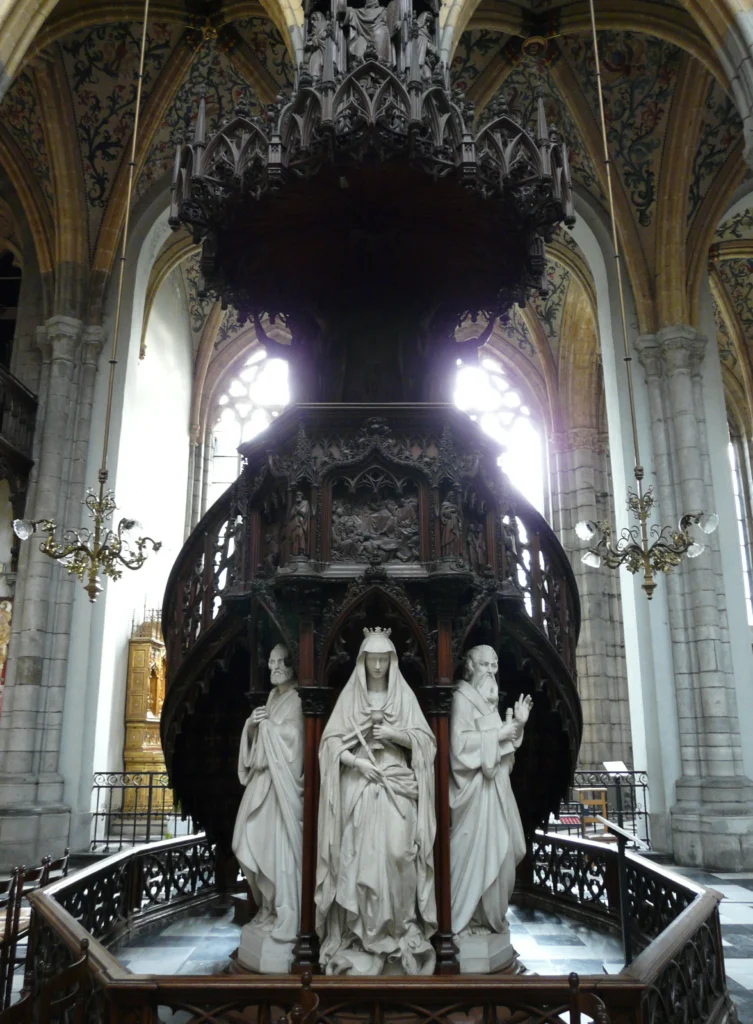
After the destruction of the dardanelle erected on the Pont des Arches in 1790, the Christ which had been above this tower since 1663, a work of Jean Del Cour, was transferred there. Since 1861, it has surmounted the interior entrance door.
French Revolution
After the Battle of Jemappes, the French pursued the imperial army and entered into Liège. The collegiate church of St. Paul was chosen to serve as a stable and slaughterhouse and was therefore almost completely destroyed. The chapter of St. Paul suffered the fate reserved for other religious buildings by revolutionary vandals: after looting the building, removing all metals, destroying the main glass windows whose lead was used to melt bullets, selling at auction the furniture, they installed a butcher’s shop for their use; the cloisters were changed into stables.
The calm restored by the triumph of the Imperials was not long-lasting. On 17 July 1794, the Convention’s armies returned to Liège and the Principality was annexed to France. The following 10 December, the Executive Board decreed a 600 million loan to cover the costs of the war.
From Collegiate Church to Cathedral
In 1802, the former collegiate church was erected as a cathedral and in 1805 the organs of the old Collégiale Saint-Pierre de Liège and most of the treasures of Saint Lambert’s Cathedral were transported there.
Return of the Relics
On 30 December 1803, the Bishop wrote to the minister of worship Portalis asking that the government pay the fees and allowances due for the brought back from Hamburg. These six boxes contained the relics of the Saints and the debris from the treasure of Saint Lambert’s Cathedral returned to the new cathedral. One month later, on 30 January 1804, Portalis replied that the government had decided that the amount of the objects delivered to Hamburg for the service of the navy would be reimbursed but that this service being extremely overburdened by the present circumstances, it could not foresee the moment when it would be liable to pay the effects which were assigned to it. The treasure of Saint-Lambert seized in Hamburg by the commissioners of the Republic who accompanied the armies was largely sold on the orders of the 1st Consul by Commissioner Lachevadière. The sale yielded nearly a million and a half that was applied to the needs of the navy.
Translation of Saint-Lambert
In execution of bishop Zaepffel’s mandate, the translation ceremony of the bust of Saint Lambert and relics of the Saints took place on 1 January 1804. It was announced the day before by the sound of the bells of all the churches. They had been stored at Saint-Nicolas Au-Trez.
Erection of the Bell Tower
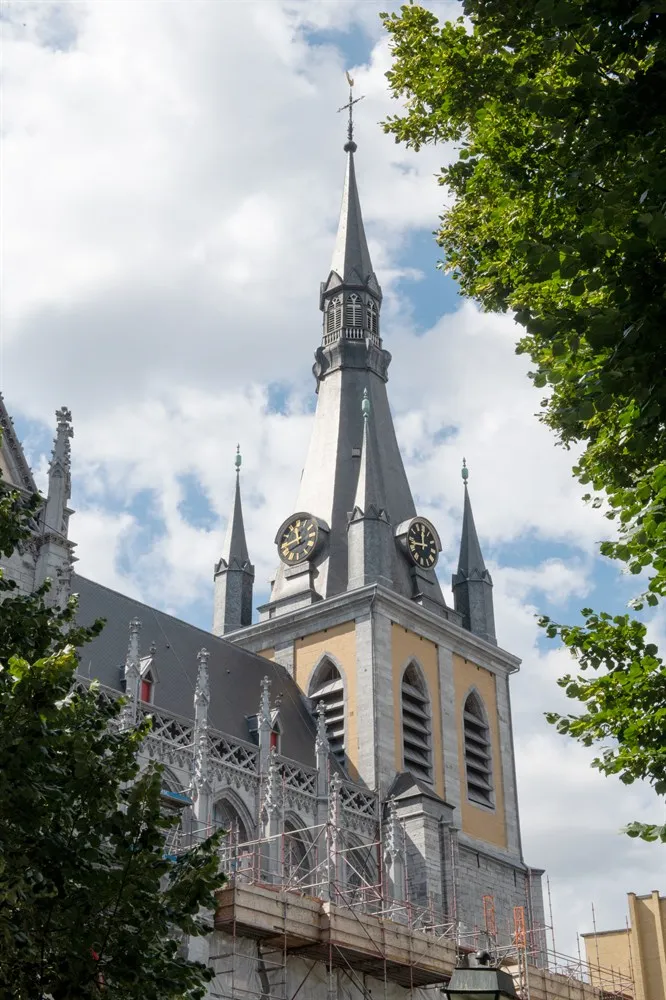
The collegiate church used to have only a small bell tower, the drawing of which can still be seen in Les Délices du Pays de Liège the chapter wished to construct a spire, seeking to reproduce the shape of that of the one of Cathédrale Notre-Dame-et-Saint-Lambert de Liège. The Cathedral Chapter met on 28 June 1810, to deliberate on the erection of a tower. The following day, 29 June, the Chapter decided to build the tower. to acquire for this purpose the spire of the tower of Sint-Truiden Abbey. But it was not until 1812, following a request from Napoleon, that the tower, with its ogival windows, was raised one floor and the bell tower was installed. The side facing west is pierced by a huge window with glowing mullions. The part that rises above it and contains the bells is built in sandstone from the square towers of the old cathedral of Saint-Lambert. On each of its three free sides there are two large windows with sound-absorbing panels. Its construction was completed at the end of October 1811, it replaced the original structure of the original tower, which until that time only rose to the height of the roof and was demolished in May of the same year. The framed arrowhead that ends the tower rises to a height of 90 meters. It was started immediately after the completion of the previous part and finished towards the end of August 1812. The cross which overlooks it was placed the following 1 October.
Chimes
The chime of the former Saint Lambert’s Cathedral which the imperial government had donated to the new cathedral in 1804 was placed here.
Restoration
In the 1850s, the cathedral underwent a major renovation by architect Jean-Charles Delsaux.
Feast Day
Feast Day : 24th April
Saint Paul feast day is still celebrated in the Cathedral on 24th April .
Church Mass Timing
Sunday : 10 am and 4.30 pm.
Church Opening Time:
Monday : 8 am – 5 pm.
Tuesday : 8 am – 5 pm.
Wednesday: 8 am – 5 pm.
Thursday : 8 am – 5 pm.
Friday : 8 am – 5 pm.
Saturday : 8 am – 5 pm.
Sunday : 8 am – 5 pm.
Contact Info
Address :
Pl. de la Cathédrale, 4000 Liège, Belgium
Accommodations
Connectivities
Airway
Liege Airport (LGG), Belgium to Liege Airport (LGG), Belgium 45 min ( 14.4 Km ).
Railway
Liège-Guillemins railway station to St. Paul’s Cathedral, Liege, Belgium distance 7 min (2.7 km) via N671.

